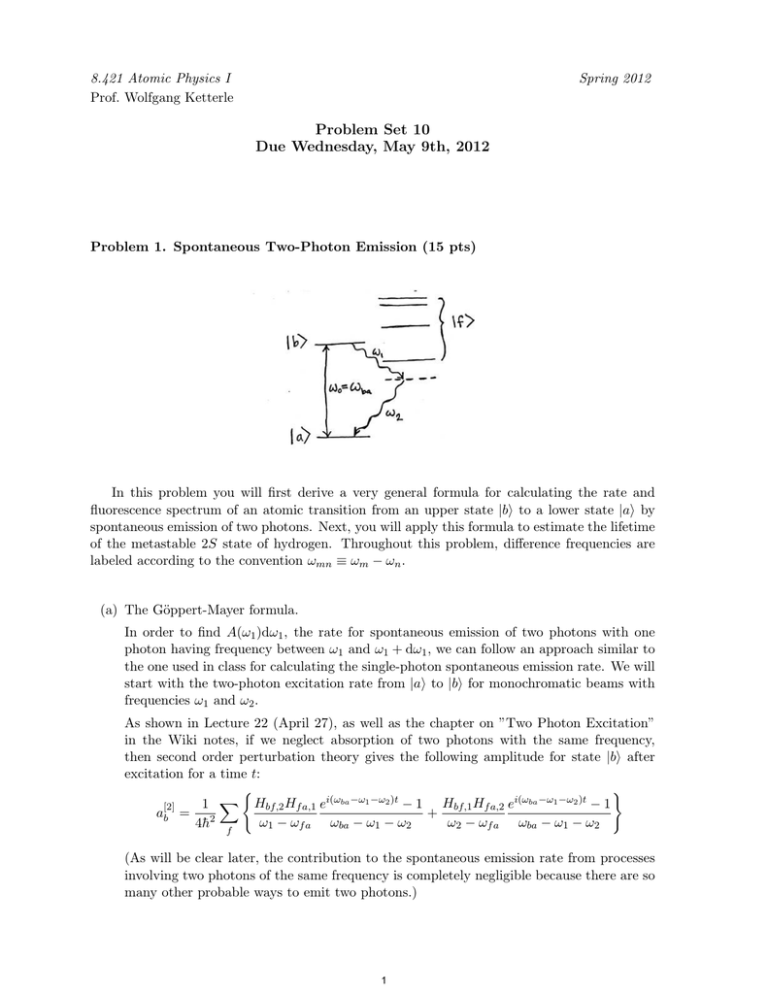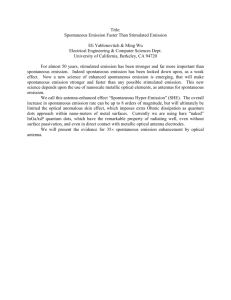Problem Set 10 Due Wednesday, May 9th, 2012
advertisement

8.421 Atomic Physics I Prof. Wolfgang Ketterle Spring 2012 Problem Set 10 Due Wednesday, May 9th, 2012 Problem 1. Spontaneous Two-Photon Emission (15 pts) In this problem you will first derive a very general formula for calculating the rate and fluorescence spectrum of an atomic transition from an upper state |bi to a lower state |ai by spontaneous emission of two photons. Next, you will apply this formula to estimate the lifetime of the metastable 2S state of hydrogen. Throughout this problem, difference frequencies are labeled according to the convention ωmn ≡ ωm − ωn . (a) The Göppert-Mayer formula. In order to find A(ω1 )dω1 , the rate for spontaneous emission of two photons with one photon having frequency between ω1 and ω1 + dω1 , we can follow an approach similar to the one used in class for calculating the single-photon spontaneous emission rate. We will start with the two-photon excitation rate from |ai to |bi for monochromatic beams with frequencies ω1 and ω2 . As shown in Lecture 22 (April 27), as well as the chapter on ”Two Photon Excitation” in the Wiki notes, if we neglect absorption of two photons with the same frequency, then second order perturbation theory gives the following amplitude for state |bi after excitation for a time t: ( ) 1 X Hbf,2 Hf a,1 ei(ωba −ω1 −ω2 )t − 1 Hbf,1 Hf a,2 ei(ωba −ω1 −ω2 )t − 1 [2] ab = 2 + ω1 − ωf a ωba − ω1 − ω2 ω2 − ωf a ωba − ω1 − ω2 4h̄ f (As will be clear later, the contribution to the spontaneous emission rate from processes involving two photons of the same frequency is completely negligible because there are so many other probable ways to emit two photons.) 1 i) Find the excitation rate Γab (ω1 ) when one beam has frequency ω1 . Your expression should include a resonance condition which constrains ω2 . ii) Show that your expression is mathematically equivalent to Γab (ω1 ) = Γba (ω1 ) = πE12 E22 e4 4 8h̄ 2 X ha|r · ê1 |f ihf |r · ê2 |bi ha|r · ê2 |f ihf |r · ê1 |bi + ω2 + ωf b ω1 + ωf b f × δ(ωba − (ω1 + ω2 )). Note that we can also obtain this expression by considering two-photon emission—one needs only to swap a and b and change the signs of ω1 and ω2 in the expression for the absorption rate. iii) Give a physical interpretation for the terms in the sum. iv) Obtain the expression of A(ω1 ). To do so, first express E12 and E22 in terms of the number of photons n1 , n2 occupying some specific modes with frequencies ω1 , ω2 . Hint: write the electric field operator E in terms of photon number raising/lowering operators a† and a. Given a coherent mode |αi, consider the expectation value of the photon number operator hni = ha† ai and the amplitude of the expectation value of the electric field hE0 i Next, replace n1 , n2 with the densities of modes at frequencies ω1 , ω2 . Proceed to calculate A(ω1 )dω1 , the two-photon spontaneous emission rate with one photon at frequency ω1 and the other photon at frequency ω2 = ωba − ω1 . (By analogy to the one-photon case, if the two-photon absorption rate is n̄1 n̄2 R, then the two-photon spontaneous emission rate is R.) At last, derive the following expression: * 2 + 4 X 8e ha|r · ê1 |f ihf |r · ê2 |bi ha|r · ê2 |f ihf |r · ê1 |bi 3 3 A(ω1 )dω1 = ω ω + 1 2 ω2 + ωf b ω1 + ωf b πh̄2 c6 f dω1 . avg The angle brackets indicate an average over all possible polarizations and directions of propagation for the two photons. (Don’t lose too much sleep if you can’t get the factor of 8 in front.) This result was first published in 1931 by Maria Göppert-Mayer, one of the first persons to investigate multi-photon processes using the new quantum mechanics. You don’t need to work this out, but the formula above can be simplified by evaluating the average and expressing the matrix elements in terms of the operator z: 2 X 8e4 1 1 3 3 dω1 . A(ω1 )dω1 = zaf zf b + 2 6 ω1 ω2 ω1 + ωf b ω2 + ωf b 3πh̄ c f (G. Breit and E. Teller, Astrophysical Journal 91, 215, (1940).) 2 (b) 2S natural lifetime. The 2S state in hydrogen decays almost exclusively by spontaneous two-photon emission. (FYI: The transition to the Lamb shifted 2 2 P1/2 level is allowed by electric dipole radiation, but owing to the small value of the Lamb shift, the transition probability is negligibly small, equivalent to a lifetime of 163 years. The magnetic dipole transition to the 1 2 S1/2 is forbidden in the non-relativistic approximation since the radial wavefunctions of the two states are orthogonal. However, after relativistic corrections, the matrix element is no longer exactly zero, corresponding to a lifetime of about five days (see Corney, Laser Spectroscopy)). We wil use the following approximations: (i) Only the 2P level contributes as an intermediate state. (ii) Use the Bohr radius a0 for both relevant matrix elements of z. (iii) Treat 2S and 2P as degenerate (namely, ωf b ' 0). For an order of magnitude estimate of the hydrogen 2S state lifetime, we can use the Göppert-Mayer formula and use the above approximations. i) Use the total spontaneous decay rate to obtain the lifetime τ of the 2S state: Z 1 1 ωba = Aτ = A(ω1 )dω1 . τ 2 0 The factor 1/2 is included since the same photon pair occurs twice when integrating from 0 to ωba . ii) Express the 2S lifetime in seconds. iii) Plot the spectrum A(ω1 ) over its entire range. The actual 2S state lifetime is 0.122 s. The higher P states as well as the continuum contribute significantly to the 2S decay rate. However, it turns out to be an arduous calculation to sum over the intermediate states accurately, even for the hydrogen atom. It was nearly three decades after Göppert-Mayer did her pioneering work that the 2S lifetime was calculated to more than one significant digit! (J. Shapiro and G. Breit, Phys. Rev. 113, 179 (1959).) To my knowledge, the 2S lifetime has not been directly measured except in ultracold, magnetically trapped hydrogen. (C. L. Cesar et al., Phys. Rev. Lett. 77, 225 (1996).) 3 Problem 2. Dark state in EIT and STIRAP (5 pts) A three-level atom with states |gi, |ei, |f i driven by two laser fields with Rabi frequencies ω1 and ω2 on the transitions |gi ↔ |ei and |f i ↔ |ei, respectively, is described in the rotating-wave approximation in the interaction picture by the Hamiltonian: 0 ω21 0 H=h ¯ ω21 ∆ ω22 0 ω22 −δ a) Show that on two-photon resonance (δ = 0) there is a dark state that has no light shift and no admixture of the excited state |ei, independent of the one-photon detuning ∆. Write down the dark state in terms of the components |f i, |gi and the Rabi frequencies ω1 ,ω2 and interpret the result. b) Now assume one- and two-photon resonance, ∆ = δ = 0. Show that the dark state can be evolved adiabatically from |gi to |f i by slowly changing the Rabi frequencies ω1 ,ω2 . This process is called STIRAP (stimulated rapid adiabatic passage), and allows you to transfer atoms between two ground states without involving loss from decay of the excited state |ei to other levels. c) Adiabaticity requires that the overlap of time derivative of the dark state with a bright state to be much less than the energy spacing of the two levels. What is the condition on ω1 , ω2 for STIRAP to be adiabatic? 4 MIT OpenCourseWare http://ocw.mit.edu 8.421 Atomic and Optical Physics I Spring 2014 For information about citing these materials or our Terms of Use, visit: http://ocw.mit.edu/terms.





